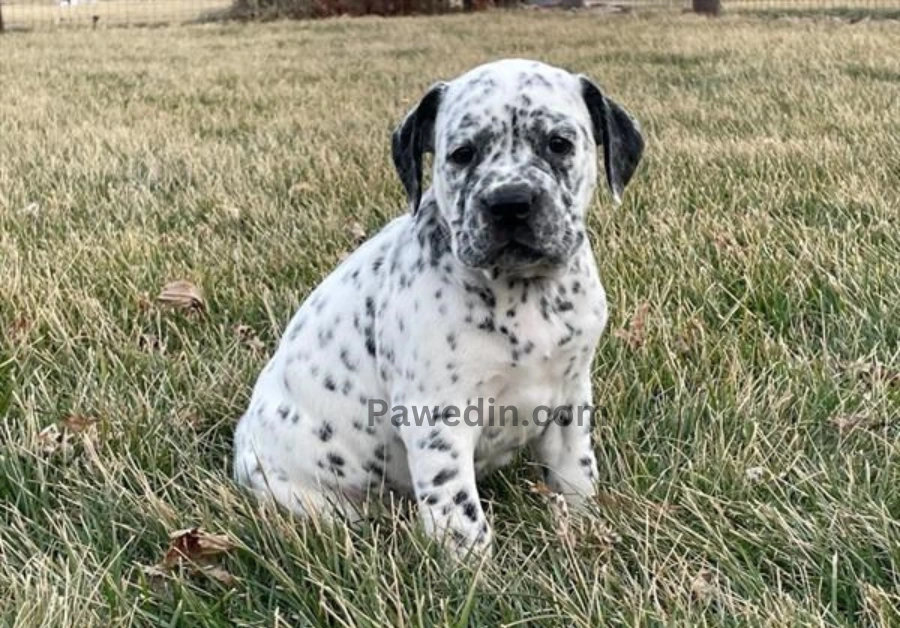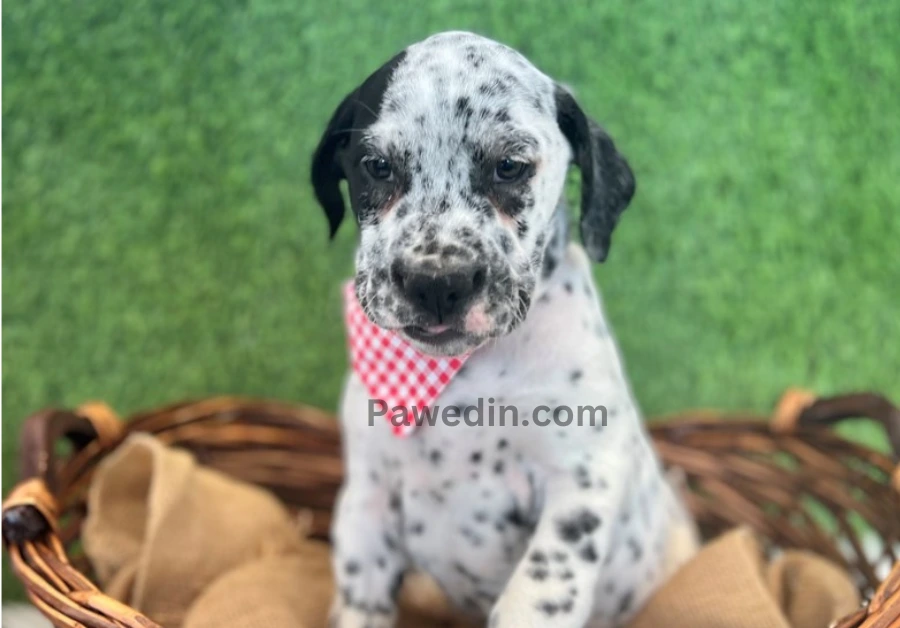Welcome to the world of the Bullmatian, The Bullmatian is a mixed-breed dog that combines the beauty of a spotted Dalmatian with the adorable appearance of a Bulldog.
The Bullmatian is intelligent, and lively, and loves agility, tricks, and family exercise. They are highly curious and friendly, making human and doggy friends wherever they go.
Bullmatians have the defending instincts of a Dalmatian and may be fairly noisy, grunting, and snoring like a Bulldog.
These dogs are known for their loving, energetic, and friendly nature, and can be found in shelters and breed-specific rescues.
They are top-notch companion dogs and require regular exercise and play sessions. However, they may be stubborn at times, making them a good fit for seasoned dog owners with experience training dogs.
Unveiling the Bullmatian
The Bullmatian is a crossbreed resulting from the intentional mating of an English Bulldog and a Dalmatian.
As a designer breed, it combines the best of both worlds— the Bulldog’s sturdy build and the Dalmatian’s striking coat pattern.
This charming blend creates an adorable and playful companion that is sure to steal your heart.
Origin and History
The Bullmatian is a designer crossbreed from Afghanistan, originating from the Dalmatian and Bulldog breeds. It is a medium-sized, medium-sized dog with a spotted coat and medium-sized body type.
Bullmatians require low maintenance, including brushing and bathing, as well as proper dental care.
Their temperament is a mix of Dalmatian and Bulldog, making them affectionate, loving, energetic, friendly, cheerful, and sweet.
Proper training in obedience and socialization is essential for the Bullmatians. To keep them active and healthy, daily runs walks, and a fenced yard are recommended.

Appearance and Physical Traits
Bullmatians are a medium-sized, mixed breed originating from the Dalmatian and Bulldog, with a strong, muscular body and a spotted and patchy coat.
They are typically 14-24 inches tall and weigh 41-65 pounds. Bullmatians are social and active, loving to follow owners and enjoy family gatherings.
Exercise is essential for their daily routine, and a fenced yard or garden is ideal. Mental stimulation is also crucial, and interactive toys should be rotated regularly.
Although loyal, Bullmatians can be stubborn, so proper training and socialization from an early age are crucial. Once they learn to trust and respect their owners, they become devoted companions.
| Weight | 41 to 65 lb |
| Lifespan | 8 to 12 years |
| Best Suited For | Individuals and families with a history of dog training, residing in a home or a sizable apartment with a yard |
| Temperament | Charming, amiable, gregarious, loving, active, and obstinate |
| Comparable Breeds | Bulldog, Dalmatian |
| Height | 11 to 24 inches |
Temperament and Behavior
Bullmatians are affectionate, loving, energetic, and friendly companion dogs with a personality akin to Dalmatian and Bulldog.
They are good with children and can be stubborn, making them difficult to train. Proper obedience and socialization are crucial for a Bullmatian’s well-being.
They thrive in moderate climates but should be insulated with coats and sunscreen for winter and air conditioning for summer.

Training and Exercise Needs
Training a Bullmatian can be challenging, especially for a stubborn breed like the Bulldog.
To ensure consistency and patience, it’s essential to socialize and train your puppy from a young age.
Use a firm, positive approach, incorporate treats, rewards, and praise, and make training sessions engaging.
If your dog is too stubborn to train on their own, consider seeking help from a professional dog trainer or school.
To keep your Bulldog active and healthy, provide daily walks, a fenced yard, and toys to keep them mentally and physically stimulated.
Caring for Your Bullmatian
Caring for a Bullmatian involves providing them with the right nutrition, grooming, and regular veterinary check-ups to keep them in top condition.
Diet and Nutrition
A Bullmatian diet should be formulated for medium-sized breeds with high energy. Their dietary needs change from puppyhood to adulthood and into senior years.
Consult a veterinarian for specific recommendations. Feed your Bullmatian two to three cups of dry food daily, preferably good-quality dry kibble.
Monitor their food intake to avoid a porky pooch and switch to a weight management kibble if necessary.
Choose high-quality, natural, whole food ingredients and divide 1.5 to 2.5 cups of dry food daily.
If incorporating canned food, reduce the amount to prevent weight gain. Bullmatians are friendly, charming, affectionate, and social.
Grooming Tips
The Bullmatian is a short-haired, straight dog with a spotted coat, ranging from brown to brindle.
It is relatively low-maintenance, requiring only three coat brushings per week. Bullmatians prefer a moderate climate, so be aware of heat exhaustion in summer and winter.
Their short, straight coat requires a quick 5-10 minute brush, and shedding is low to moderate.
Regular brushing helps maintain healthy hair and skin, promotes better blood flow, and reduces odor.
Regularly cleaning skin folds with a skin fold cleanser and cotton buds helps prevent bacterial infections and reduce odor.
Grooming together helps maintain a strong friendship bond, and the Bullmatian’s short and straight coat allows for easy maintenance and grooming.

Common Health Issues
Although bullmatians tend to be healthy dogs, they can have problems that are passed down from their parent breeds.
It’s crucial to be informed of these health issues as a responsible Bullmation owner in order to identify problems early.
Bullmatians may also suffer from minor conditions like deafness, serious conditions like entropion, skinfold dermatitis, bleeding, and brachycephalic syndrome.
It is not guaranteed that a dog will ever suffer from these problems, and long-term health cannot be determined.
Becoming aware of these issues can help provide necessary veterinary care sooner.
Why Choose a Bullmatian?
For all the reasons mentioned so far, bullmastiffs are a great choice for families, but there is a catch.
Just make sure he doesn’t become bored. He might become extremely obstinate and destructive if he gets bored.
So be sure to keep him active and mentally engaged throughout the day.
He will form close bonds with the children as a family friend and be eager to win over the adults as pack leaders.
Teaching your kids how to interact with your Bullmation through planned play and interactive games is a simple method to keep them stimulated.
In this manner, everyone benefits and the situation won’t get overly raucous and out of control. Be sure to keep an eye on them due to their increased stature in case there is an unintentional bump.
Notable Facts and Trivia
- The Bullmatian is also known as the “Dalmabull” or “Bulldog Dalmatian Mix.”
- This designer breed has gained popularity in recent years, especially among families and dog enthusiasts.
Male vs. Female
The only clear noticeable variation between male and female Bullmatians is size. As a general rule, men will be taller and more muscular, making them heavier than women.
The only circumstances in which a puppy’s temperament will differ significantly are those in which the puppy has experienced an unfavorable upbringing, insufficient training, or insufficient exercise.
This can make any dog agitated and difficult, which is why it’s crucial that you do your study on Bullmations.

Conclusion
The Bullmatians is undoubtedly a delightful and lovable canine companion, offering the perfect blend of the English Bulldog and Dalmatian.
With its friendly demeanor, striking appearance, and devotion to its family, it’s no wonder that more and more people are choosing this hybrid breed as their new best friend.
Explore more:
- Dog foods and nutrition to keep your doggy healthy
- Common dog health issues and care
- Master the art of dog grooming with these hacks
- What are the different types of dog breeds
FAQs
Q1: Are Bullmatians suitable for first-time dog owners?
Absolutely! Bullmatians’ friendly and gentle nature makes them an excellent choice for first-time dog owners. They are easy to train and adapt well to different living environments.
Q2: How much exercise do Bullmatians need daily?
Bullmatians require moderate exercise daily. A couple of walks and play sessions will keep them happy and healthy.
Q3: Are Bullmatians prone to excessive barking?
While Bullmatians can bark to alert their owners, they are not considered excessive barkers. Proper training and socialization can help keep barking in check.
Q4: Do Bullmatians get along with other pets?
Yes, Bullmatians are generally sociable and get along well with other pets, especially when introduced at a young age.
Q5: Do Bullmatians have any special dietary requirements?
Bullmatians thrive on a balanced diet rich in protein and essential nutrients. Consult with your veterinarian to determine the best diet plan for your furry friend.
